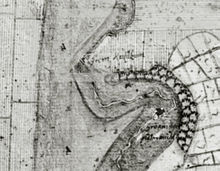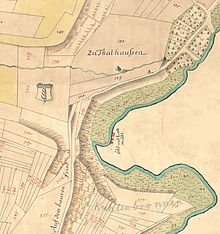Pulvermühle (Grüningen)

The powder mill of the Württemberg official city of Grüningen , today Markgröningen in the Ludwigsburg district , was a water mill on the Glems , which was built in 1662 between the "Kühlenbronn" and " zu Thalhausen " pools for the production of black powder .
history
Enforcement deficit
In the course of rearmament after the Thirty Years War , Duke Eberhard III decided. von Württemberg 1660, instead of the black powder mill at Leudelsbach near Möglingen , which was destroyed in the war, a powder factory was built at the more water-rich " Klembß " near Grüningen within a month . The Grüninger Vogt Erhard Faber, who was entrusted with the promotion of this project, was not very enthusiastic about the settlement of such a high-risk company. For two years, the Vogt succeeded in slowing down the unpopular project in the interests of the protesting farmers and " Wengerter " who cultivated neighboring properties, and the " Loh- und Walkmüller " who lived only around 100 meters upstream . After complaints from those involved in the project, Faber was reprimanded by the ducal chancellery and had to support the construction of the powder mill from March 25, 1662, which was not able to start operating until the end of the year due to start-up difficulties.
For the time being, the first powder miller Johann Sebastian Ziegler and his servant were supposed to only produce coarse “piece of powder” for the cannons of the neighboring Hohenasperg fortress . Salpetersalz had the Salpetersieder to deliver in Grüningen.
The big bang
On March 4, 1665, “the powder maker there the salt came on”, as the Vogt reported, and the mill exploded. The roof and a house wall were blown away. The external powder magazine and the staff were fortunately spared: "The powder maker and his servant, having gone to eat a piece of bread from the mill in the sun, did not catch it," said the Vogt in his report to the sovereign. Such disasters were not uncommon. If the powder self-ignited without a lightning strike or mechanically generated sparks, it was probably due to electrostatic causes that were not known at the time.

open end
How long the powder mill was operated after its controversial reconstruction has not been verified. The last mention in the files comes from 1825, when Jakob Reuter bought "Wiesen bei der Pulvermühlin". This indication of the location is not sufficient as evidence of ongoing powder production. Especially since at this location between the Gewann Kühlenbronn and Talhausen only one “ Öhl and Lohmühl ” is recorded on the “outside field map” from 1752 and a paper mill was built here in 1787 , which was hardly operated in parallel to black powder production because of the high risk potential .
See also
literature
- Hilde Fendrich: “It didn't catch the powder maker”. The big bang. In: Müller, Mühlen, Wasserkraft . Volume 5 of the series Through the city glasses . Edited by the Working Group on History Research, Heritage and Monument Preservation Markgröningen, Markgröningen 1995, pp. 128–141.
References and comments
- ↑ The forest map for the Duchy of Württemberg drawn up by Andreas Kieser in 1682 is south (south is up). Source: Forest map 159 leo-bw.de / Photo archive of the Baden-Württemberg State Media Center .
- ^ Copper engraving by Georg Andreas Böckler (1661). Source: Deutsche Fotothek (Saxon State Library).
- ↑ The hamlet of Talhausen, about 400 meters downstream, was destroyed in the Thirty Years War and was not repopulated until after 1760.
- ↑ Source: Main State Archives Stuttgart, A 249, Bü 1664.
- ↑ Hilde Fendrich: “It didn't catch the powder maker”. The big bang . In: Müller, Mühlen, Wasserkraft . Volume 5 of the series Through the city glasses . Ed. Working group for historical research, heritage and historical preservation Markgröningen, Markgröningen 1995, p. 128f ("erdapt" = caught).
- ↑ Hilde Fendrich: “It didn't catch the powder maker”. The big bang. In: Müller, Mühlen, Wasserkraft . Volume 5 of the series Through the city glasses . Edited by the Working Group on Historical Research, Heritage and Monument Preservation Markgröningen, Markgröningen 1995, pp. 137ff.
- ↑ Hilde Fendrich: “It didn't catch the powder maker”. The big bang. In: Müller, Mühlen, Wasserkraft . Volume 5 of the series Through the city glasses . Edited by the Working Group on Historical Research, Heritage and Monument Preservation Markgröningen, Markgröningen 1995, p. 141.
- ↑ Field map from 1752 ( landesarchiv-bw.de - N 1 No. 85 )
Web links
Coordinates: 48 ° 54 '42 " N , 9 ° 3' 44.8" E

